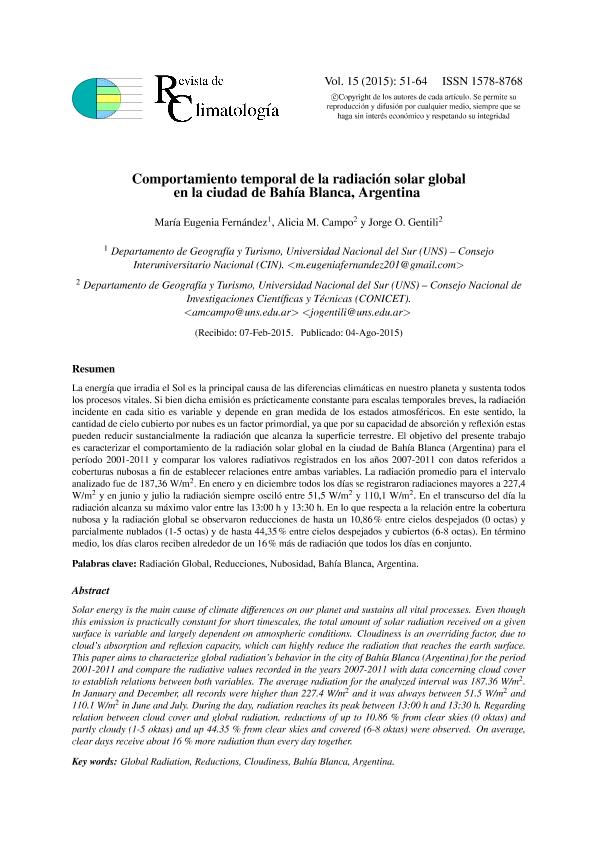Artículo
Comportamiento temporal de la radiación solar global en la ciudad de Bahía Blanca, Argentina
Fecha de publicación:
04/08/2015
Editorial:
Revista de Climatología
Revista:
Revista de Climatología
e-ISSN:
1578-8768
Idioma:
Español
Tipo de recurso:
Artículo publicado
Clasificación temática:
Resumen
Solar energy is the main cause of climate differences on our planet and sustains all vital processes. Even though this emission is practically constant for short timescales, the total amount of solar radiation received on a given surface is variable and largely dependent on atmospheric conditions. Cloudiness is an overriding factor, due to cloud’s absorption and reflexion capacity, which can highly reduce the radiation that reaches the earth surface. This paper aims to characterize global radiation’s behavior in the city of Bahía Blanca (Argentina) for the period 2001-2011 and compare the radiative values recorded in the years 2007-2011 with data concerning cloud cover to establish relations between both variables. The average radiation for the analyzed interval was 187.36 W/m2 . In January and December, all records were higher than 227.4 W/m2 and it was always between 51.5 W/m2 and 110.1 W/m2 in June and July. During the day, radiation reaches its peak between 13:00 h and 13:30 h. Regarding relation between cloud cover and global radiation, reductions of up to 10.86 % from clear skies (0 oktas) and partly cloudy (1-5 oktas) and up 44.35 % from clear skies and covered (6-8 oktas) were observed. On average, clear days receive about 16 % more radiation than every day together.
Palabras clave:
Radiación Global
,
Reducciones
,
Nubosidad
,
Bahía Blanca
,
Argentina
Archivos asociados
Licencia
Identificadores
Colecciones
Articulos(CCT - BAHIA BLANCA)
Articulos de CTRO.CIENTIFICO TECNOL.CONICET - BAHIA BLANCA
Articulos de CTRO.CIENTIFICO TECNOL.CONICET - BAHIA BLANCA
Citación
Fernández, María Eugenia; Campo, Alicia María; Gentili, Jorge Osvaldo; Comportamiento temporal de la radiación solar global en la ciudad de Bahía Blanca, Argentina; Revista de Climatología; Revista de Climatología; 15; 4-8-2015; 51-64
Compartir




